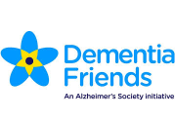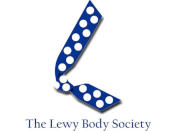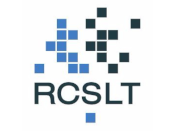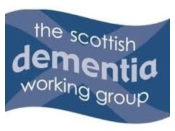
Living with dementia: furniture and furnishings
Living with dementia: furniture and furnishings
This factsheet is available for sponsorship, email marketing@dlf.org.uk
Sponsorship has no influence on our impartial content
Factsheet contents
- Introduction
- Living room
- Chairs
- Seating accessories
- Standing aids
- Bedroom
- Beds
- Getting in and out of bed
- Wardrobes and chests of drawers
- Assessing your needs
- Provision of equipment
- Funding sources for care
- For further advice from us
- Contributors
- Useful organisations and resources
- References and further reading
Introduction
The way in which a home environment is designed and laid out can have a big impact on a person with dementia.
- They may find it difficult to differentiate between things that are the same or of a similar colour - for example if a door is a similar or the same colour as the wall or door frame, or the floor is much the same colour as the walls. Furniture that is a similar colour to the floor and/or walls may also 'blend in' and effect the ability to use it safely. Using bright and contrasting colours for furniture and furnishings can help them see things more easily (Alzheimer’s Society, 2018).
- Surfaces and designs can also be confusing - a polished floor may look wet and slippery, a change of colour may look like a step and lines, or patterns across the flooring may look like an obstacle that needs to be stepped over.
- Loose rugs and mats should also be avoided as they can also look like obstacles to step over and constitute a trip hazard. Similarly a small contrasting pattern may be more difficult to see rather than a large unobtrusive pattern.
- Laminate or vinyl flooring can be noisy to walk on; soft furnishings can improve the acoustics of a room by absorbing excess sound.
- Good lighting can help reduce disorientation and reduce the risk of falls. Using higher wattage bulbs where possible and ensuring that there is plenty of natural daylight by opening curtains and removing unnecessary blinds or net curtains, as well as cutting back any shrubs or trees that might be blocking the light can be helpful. Light switches should be easy to locate and use.
Making it easier to navigate around the home and taking lighting and colour schemes into account is very important in reducing the risk of confusion and disorientation, and can enable the person to remain at home safely for longer.
Living room
Chairs
A person with dementia may have reduced mobility and show symptoms such as:
- unsteady or shuffling gait
- poor balance
- a decrease in physical strength and coordination
- anxiety and confusion.
These can all affect a person's ability to get in and out of a chair - they may no longer be able position themselves well before sitting, they may drop down onto the seat rather than gently lowering them-self or they may be unable to get in a safe and comfortable seating position. Also when standing up from a sitting position there may be an increased risk of falls. A wide range of riser and riser/recliner chairs, upright high back chairs and chair accessories are available that can help an individual to sit in a comfortable, well supported position and to sit down and stand up safely.
 A person in the earlier stages of dementia is likely to be able to operate a recliner or riser recliner chair quite safely if they are already familiar to the user.
A person in the earlier stages of dementia is likely to be able to operate a recliner or riser recliner chair quite safely if they are already familiar to the user.
These types of chairs can help to guide the user gently down into the chair and back up to a standing position again, ready to walk away - helping to maintain their balance and reduce the risk of falls.
When choosing a chair it is advisable to opt for one with a remote control that has large clear buttons in a contrasting colour to the remote's body, and use this from the outset, as later changes may cause confusion.
In the later stages of dementia, increased memory loss, confusion and reduced cognition can make the use of these chairs unsafe, as there is a risk of incorrect or accidental use of the control, which could potentially result in the person tipping themselves out of the chair. In this case the carer should be operating the control and assisting and reassuring them to sit or stand.
As the condition progresses, the person with dementia may experience a loss of physical abilities such as maintaining a good sitting posture or holding the head up. Appropriate seating can reduce the risk of problems related to poor posture such as swallowing, breathing and range of vision for example. Good sitting posture can also reduce the risk of pressure injuries.
For more complex seating to address these issues - for example chairs with a tilt-in space function, integral pressure relieving properties, optional parts such as lateral and/or head supports, elevating leg rests/foot supports, harnesses or trays, or made to measure or bespoke chairs - an Occupational Therapy seating assessment is recommended to ensure that the correct seating is provided.
Recliner chairs
Recliner chairs can be manually or electronically operated. Manually operated chairs require a degree of strength and co-ordination to operate successfully. They either have a handle on the side that can be pulled to make the back recline and the leg support rise, or they are operated by pushing back with the body against the backrest. Recliner chairs are useful in helping the elevation of the legs which can relieve swelling. However, the person with dementia will need to have the ability to get out of the chair independently, as recliner chairs do not offer a riser facility.
Riser recliner chairs
 As well as the backrest reclining and leg rest rising, these chairs have a rise function which can help in sitting or standing.
As well as the backrest reclining and leg rest rising, these chairs have a rise function which can help in sitting or standing.
Electronically operated chairs have either single or dual motors and are operated by a handset that is attached to the chair. Single motor means that the backrest, leg rest and the rise function are operated together, and dual motor means that the backrest, leg rest and rise function can be operated separately. Dual motors have more complex controls than single motors as they have more buttons on them.
If there are also small children or pets in the property, then a built-in safety feature designed to prevent accidents, e.g. should they crawl under the chair, should be considered. These consist of either a barrier to prevent anything getting under the chair, or a sensor which will detect if there is anything under the chair and trigger a halt mechanism.
Chairs with manual seat risers
 Chairs with manual seat risers have a seat that is hinged along the front edge and have a gas operated mechanism and coiled or pneumatic springs to tilt the seat forwards.
Chairs with manual seat risers have a seat that is hinged along the front edge and have a gas operated mechanism and coiled or pneumatic springs to tilt the seat forwards.
There is a locking mechanism that secures the seat down, so that the tilt mechanism cannot come into play accidentally. The lifting or tilt mechanism must be adjusted according to the user’s weight so that the right amount of assistance is given. In some chairs this mechanism can be pre-set by the manufacturer.
The user must be able to bring their weight forward when sitting in the chair and have sufficient strength in the arms to lift the body which will trigger the mechanism. They should also be able to place their feet in a good position and maintain their balance when moving into a standing position.
An Occupational Therapy seating assessment is recommended before considering a chair with a manual seat riser. There is an opinion that these types of chairs are not suitable for people living with dementia as the lift is not controlled and this could surprise the occupant, inadvertently causing them to fall. Chairs with manual seat risers are unsuitable for people with poor trunk control or balance.
Riser cushions
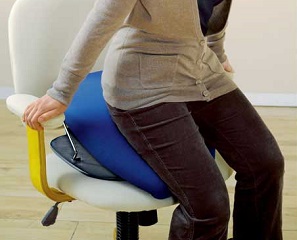 Riser cushions are portable automatic lifting seats that use pistons to provide lift. They should only be used on a chair with armrests and a solid seat base and the riser cushion should fit snugly in the chair to prevent excess movement. The existing chair cushion must be removed, as placing the riser cushion on top of it will not provide a stable enough base and will increase the height of the seat.
Riser cushions are portable automatic lifting seats that use pistons to provide lift. They should only be used on a chair with armrests and a solid seat base and the riser cushion should fit snugly in the chair to prevent excess movement. The existing chair cushion must be removed, as placing the riser cushion on top of it will not provide a stable enough base and will increase the height of the seat.
The maximum weight capacity of the riser cushion is approximately 136 kg (21 ½ stone).
These can be very unstable. An Occupational Therapy seating assessment is recommended before considering a riser cushion.
High back chairs
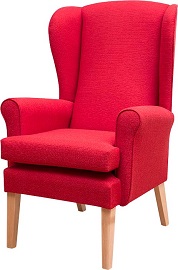 High back chairs are fixed position upright chairs with wooden legs.
High back chairs are fixed position upright chairs with wooden legs.
Some have wings on the sides of the chair towards the top of the back rest. Wings can be useful to prevent droughts and provide some head support, but they can reduce side vision and hearing.
There are usually various options in terms of colour and material to choose from. Although vinyl is easy to clean, it is preferable to choose a breathable type of fabric, as vinyl can cause sweating in hot weather and lead to a risk of moisture lesion development in those with fragile skin.
Adjustable high back chairs are available with seat height and depth and back height adjustments.
Settees
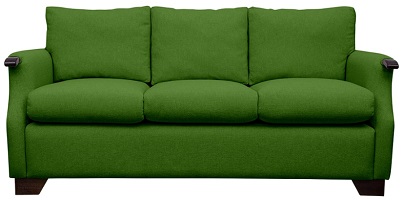 Settees often have a low seat height and can be more difficult to get up from as they only have an arm on one side that the person can push up from. This can increase the risk of falls while sitting down or getting up from them. Opting for a settee with a higher seat height (e.g. 46cm and above) can help a person to stand. This height would be suitable for most people but people with shorter leg length may find these settees too high.
Settees often have a low seat height and can be more difficult to get up from as they only have an arm on one side that the person can push up from. This can increase the risk of falls while sitting down or getting up from them. Opting for a settee with a higher seat height (e.g. 46cm and above) can help a person to stand. This height would be suitable for most people but people with shorter leg length may find these settees too high.
Seating accessories
Chair movers
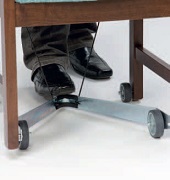 Dining chairs can be difficult to move into and out from a table. A foot operated chair mover used by a carer or family member can to help with moving the seated person closer to the table. These can be attached to most dining chairs.
Dining chairs can be difficult to move into and out from a table. A foot operated chair mover used by a carer or family member can to help with moving the seated person closer to the table. These can be attached to most dining chairs.
Chair raisers
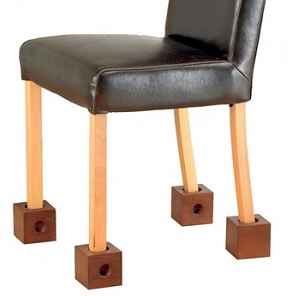 Chair raisers are attached to the legs of chairs to raise the seat height of the chair or settee and they can help to make it easier for the user to stand up and sit down from the chair. Using chair raisers can enable a person to continue to use their own chairs which are familiar to them.
Chair raisers are attached to the legs of chairs to raise the seat height of the chair or settee and they can help to make it easier for the user to stand up and sit down from the chair. Using chair raisers can enable a person to continue to use their own chairs which are familiar to them.
They are available in a variety of styles and come in sets of four. Some attach individually to each leg by a rubber grip or are screwed into the base of the chair at each corner. Others have cups that the legs or castors sits in and are joined together with link arms. These interconnected chair raisers tend to be more stable.
Chairs can be more difficult to move if they have raisers attached, and the raisers should always be checked after moving a chair. Some chair raisers can also constitute a trip hazard as they can stick out a little, and a chair may be more at risk of tipping if raised.
An occupational therapy seating assessment is recommended before considering using chair raisers.
One-way glides
 One-way slide or glide sheets consist of a tube of fabric that is designed to slide in one direction only and is placed on the seat of a chair to prevent the person from sliding.
One-way slide or glide sheets consist of a tube of fabric that is designed to slide in one direction only and is placed on the seat of a chair to prevent the person from sliding.
Dementia can cause sleep disturbances which can result in fatigue and decreased alertness. This can result in a tendency to lean over to one side or slide down in the chair. One-way glides can be helpful for the person with dementia who may find it difficult to maintain their position in the chair. However, care should be taken that they are not placed the wrong way round as the user could slide out of the chair. There is also a risk of skin shearing and they should not be used on top of a pressure relieving cushion.
The material on a glide sheet favours sliding to the back of the chair and restricts movement to the front. Getting out of a chair with a one way glide would be difficult as there is friction when sliding forward to stand up.
An occupational therapy seating assessment is recommended before considering using a one-way glide.
Foot stools
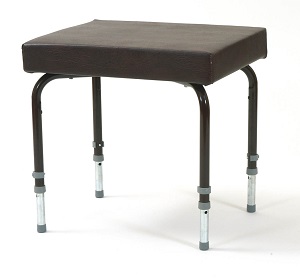 Foot stools are useful for elevating the legs when sitting.
Foot stools are useful for elevating the legs when sitting.
A person with dementia may feel discomfort or pain in their feet that could be related to a number of conditions such as oedema, bunions, toe nail problems, or general soreness from incorrectly fitting shoes. Elevating the legs can increase comfort and reduce pain or help prevent a condition from deteriorating.
In the earlier stages of dementia a person may be able to move the foot stool out of the way prior to standing up, but those with memory loss or in the later stage of the condition may find it difficult to move the footstool into the correct position when sitting, or out of the way before moving to stand up, which could result in them tripping over it. Carers or family members can prompt the person to use it safely, or can assist with correct positioning.
An assessment by an occupation therapist would need to be completed to ensure that the person is able to use a footstool safely.
Cushions and loose covers
Cushions and loose covers can help to increase comfort.
Selecting and using contrasting colours, so the cushion or loose cover stands out, will help a person with dementia differentiate between the cushion or loose cover and the seat. Soft fabrics that won’t irritate the skin are preferable.
Pressure cushions
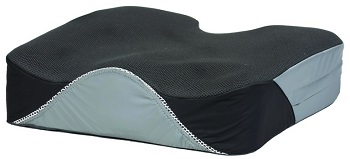 Pressure cushions usually contain foam, gel or air and are used to reduce the risk of a person who sits for long periods of time, or is not able to adjust their position in the chair, from developing pressure ulcers on their bottom. A person with dementia has an increased risk of developing pressure ulcers as they may have experienced these difficulties, or their movement may have been limited to reduce the risk of falls. Poor diet, reduced fluid intake, incontinence and agitation or restlessness can all increase the risk of pressure ulcer development.
Pressure cushions usually contain foam, gel or air and are used to reduce the risk of a person who sits for long periods of time, or is not able to adjust their position in the chair, from developing pressure ulcers on their bottom. A person with dementia has an increased risk of developing pressure ulcers as they may have experienced these difficulties, or their movement may have been limited to reduce the risk of falls. Poor diet, reduced fluid intake, incontinence and agitation or restlessness can all increase the risk of pressure ulcer development.
Assessment by a tissue viability expert is essential if there is a risk of a pressure ulcer from developing.
Further reading: DLF's factsheet Choosing pressure relief equipment.
Standing aids
If the person with dementia is struggling to get in and out of the chair then there are a number of aids available for the carer to use to assist with this.
An Occupational Therapy assessment is essential to ensure that the correct equipment is used and a risk assessment should be completed.
Standing aids are available in a range of styles and can help the carer to assist the person with dementia who may have poor balance and find moving from or stepping round from one seat surface to another (e.g. wheelchair to toilet) difficult.
Standing aids have a base that rotates or can be wheeled round which the person stands on and a frame for them to hold on to. The carer can then swivel them round, removing the need for awkward twisting. Good upper body strength, so they can pull themselves up to standing or lower themselves down onto a seat, and the ability to weight bear are essential for these to be used successfully.
Handling belts
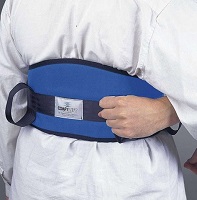 Handling belts are padded with soft handles that fit around the person's waist and are used to help a carer to guide the wearer when sitting or standing or to move from one surface to another. They can be used in conjunction with some stand aids.
Handling belts are padded with soft handles that fit around the person's waist and are used to help a carer to guide the wearer when sitting or standing or to move from one surface to another. They can be used in conjunction with some stand aids.
A handling belt can provide reassurance and allow the carer to assist without holding onto the person or their clothing. They should never be used to lift or pull someone up.
A person with dementia may feel anxiety or confusion when being assisted to move or may dislike being touched. Before using a handling belt it is important to familiarise the person with dementia with the equipment in order to minimise any anxiety.
Bedroom
It may be difficult for the person with dementia to recognise which room is their bedroom, especially if there are several doors that look the same. Putting a picture or photo, or a sign or symbol on the bedroom door can help. Making sure that there are easily recognisable and familiar personal items clearly visible, such as jewellery, familiar photographs or perfumes and lotions can be reassuring and helpful. The bed should be clearly visible with bed covers in contrasting colours to the surrounding area, and easy to access from any direction. Having a bed with raised edges may reduce the risk of the person falling out of bed.
Mirrors may cause the person with dementia to become anxious or frightened when they catch their reflection, as they may not recognise the person who is looking back at them. If this is the case then it would be advisable to cover or remove them (Social Care Institute for Excellence 2015).
Beds
Community profiling beds
 A person with dementia may experience reduced core strength, mobility and balance and have an increased risk of falls as the condition progresses and this can impact on their ability to get in and out of a bed safely. Increased anxiety may also have an impact on bed mobility. Profiling beds can help the person with dementia to get in and out of, and adjust their position in bed.
A person with dementia may experience reduced core strength, mobility and balance and have an increased risk of falls as the condition progresses and this can impact on their ability to get in and out of a bed safely. Increased anxiety may also have an impact on bed mobility. Profiling beds can help the person with dementia to get in and out of, and adjust their position in bed.
These beds are often supplied by equipment services and require assessment from an Occupational Therapist or other health professional. They are specially designed manually or electronically operated beds that can be adjusted to the needs of the user. The mattress platform is divided into sections, allowing different sections of the bed to be positioned at different heights and angles.
There are a number of types of community bed available. High-low beds are height adjustable only, and do not have the option to raise the head or leg/knee section.
 Other profiling beds have the mattress platform made up of two, three or four sections. In two section beds only the headrest can be raised, in three section beds both the headrest and knee break/leg rest can be raised and in four section beds both the headrest and knee break/leg section can be raised. There is also small fixed platform in-between the head and leg sections.
Other profiling beds have the mattress platform made up of two, three or four sections. In two section beds only the headrest can be raised, in three section beds both the headrest and knee break/leg rest can be raised and in four section beds both the headrest and knee break/leg section can be raised. There is also small fixed platform in-between the head and leg sections.
Some have a function called ‘Trendelenburg’ which can tilt the whole mattress platform so that one end of the platform is higher than the other. This should only be used on the recommendation of a health professional. Others are fitted with a function called ‘autoregression’ which ensures minimum pressure is placed on the sacrum region (an area located at the base of the spine) and helps reduce skin shearing when the bed is profiled.
If a profiling bed is used nothing should be placed underneath it, as many profiling beds do not stop automatically and there is a risk of entrapment.
Profiling beds that look more like ordinary divan beds can also be purchased privately.
Floor beds
 Floor beds are profiling beds in which the mattress platform can be lowered to within a few inches of the floor. This can reduce the risk of injury if the person with dementia falls out of bed, or reduce their anxiety about falling out of bed.
Floor beds are profiling beds in which the mattress platform can be lowered to within a few inches of the floor. This can reduce the risk of injury if the person with dementia falls out of bed, or reduce their anxiety about falling out of bed.
A bedside padded floor mat can be used next to the bed so there is a soft surface for the person to roll onto, and which can help them to get back into bed.
Getting in and out of bed
An Occupational Therapy assessment is recommended before using the following products.
Pillow lifts
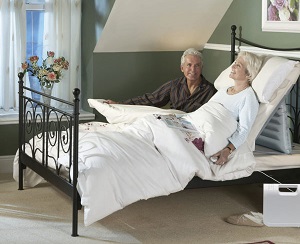 Pillow lifts are electronically controlled reclining backrests that fit on top of the mattress and under the pillow and are operated with a hand control. These are a good option for the person in the earlier stages of dementia who is starting to find sitting up in bed more difficult, or who is spending more time in bed and needs to sit up to complete activities such as eating and drinking.
Pillow lifts are electronically controlled reclining backrests that fit on top of the mattress and under the pillow and are operated with a hand control. These are a good option for the person in the earlier stages of dementia who is starting to find sitting up in bed more difficult, or who is spending more time in bed and needs to sit up to complete activities such as eating and drinking.
Some pillow lifts use air compressors to fill an air sack which inflates and raises the lift, which can be noisy and may be disturbing for the person with dementia. The hand controls are a basic design with two buttons, one for up and one for down. Some pillow lifts can feel unstable, so a degree of core strength and upper body stability is essential. As dementia progresses some people may require the assistance of their carer or family member to use the controls.
Mattress elevators
 Mattress elevators are similar to pillow lifts but fit under the existing mattress. They fit both single and double beds and act as electronically controlled backrests, lifting the whole width of the head of the mattress. Hand grab rails are available for use with some mattress elevators.
Mattress elevators are similar to pillow lifts but fit under the existing mattress. They fit both single and double beds and act as electronically controlled backrests, lifting the whole width of the head of the mattress. Hand grab rails are available for use with some mattress elevators.
Mattress elevators are more difficult to fit than pillow lifts, but are more stable. They will not be suitable for use with all mattresses such as thick memory foam or pressure relieving air mattresses. As dementia progresses some people may require the assistance of their carer or family member to use the controls of the mattress elevator.
If the user is sharing a bed with a partner this may not be a practical option.
Leg lifters
Leg lifters are devices that can help a carer to assist a person to get their legs in and out of bed.
A person with dementia may find this activity difficult due to reduced leg strength, reduced cognition or increased anxiety, and they may not accept their carer assisting to lift legs into bed.
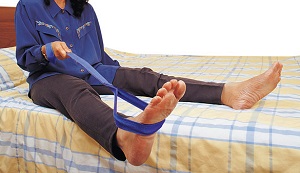 The simple dog-lead leg lifter has a loop at either end, one for the hand to go through so it can be held firmly and one at the other end, which is more rigid, for the foot to go into. The foot is then lifted and swung round onto the bed. Electronically operated leg lifters that attach to the side of the bed have a platform that raises and are operated by a hand control.
The simple dog-lead leg lifter has a loop at either end, one for the hand to go through so it can be held firmly and one at the other end, which is more rigid, for the foot to go into. The foot is then lifted and swung round onto the bed. Electronically operated leg lifters that attach to the side of the bed have a platform that raises and are operated by a hand control.
Some use air compressors to fill an air sack which inflates and raises the lift. These can be noisy and may be disturbing for the person with dementia.
Good sitting balance and upper body strength is required for successful use and would not be suitable for a person in the later stages of the condition.
Bed grab rails
 A person with dementia may have increased difficulty in getting in and out of bed or moving on to the bed due to a degree of reduced core strength, poor balance, reduced cognition or increased anxiety. Bed grab rails can provide a firm hold.
A person with dementia may have increased difficulty in getting in and out of bed or moving on to the bed due to a degree of reduced core strength, poor balance, reduced cognition or increased anxiety. Bed grab rails can provide a firm hold.
Bed grab rails can be fitted to existing divan or slatted beds. They have a section that slides under the mattress, fixed to a small grab rail that sits neatly onto the side of the mattress. Some have straps to fix them in position.
Bed grab rails are also available that either bolt onto the side of most metal framed hospital/community profiling beds or have a plate that fits underneath a wooden profiling bed. It is imperative that they are fitted in the correct position as there is a risk of entrapment. Also, it is important to ensure that the correct bed grab rail is used, as models for slatted and divan beds differ.
Good grip and reasonable upper body strength is required to use these successfully.
Bed raisers
 Bed raisers attach to the legs of the bed to raise the height of the mattress platform. They can make it easier for the person with dementia to stand up and sit down from the bed if they have reduced strength in their legs and poor balance.
Bed raisers attach to the legs of the bed to raise the height of the mattress platform. They can make it easier for the person with dementia to stand up and sit down from the bed if they have reduced strength in their legs and poor balance.
They are available in a variety of styles and come in sets of four. Some attach individually to each leg by a rubber grip or are screwed into the base of the chair at each corner, and others have cups that the legs or castors sits in and are joined together with link arms.
All legs or castors on the bed should be raised, not just ones at the corners. Beds can be more difficult to move if they have raisers attached and the raisers should always be checked after moving the bed. Some bed raisers can also constitute a trip hazard as they can stick out a little.
Bed rails
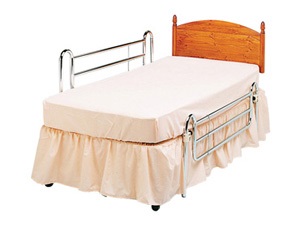 Bed rails (cot sides) attach to the side of the bed to prevent a person from falling out of bed.
Bed rails (cot sides) attach to the side of the bed to prevent a person from falling out of bed.
The person with dementia may have an increased risk of falls when attempting to get out of bed due to reduced mobility and balance. Bed rails can provide security as well as preventing falls.
They should not be used if the person is likely to get up from the bed independently as they may attempt to climb over them and this could result in injury. A bed rail risk assessment should always be completed by the health professional as there is a risk of entrapment if incorrectly fitted. Bed rails must meet bed rail regulations.
Further reading: The Medicines and Healthcare Products Regulatory Agency (MHRA) guidance on managing and using bed rails safely.
Bed bumpers
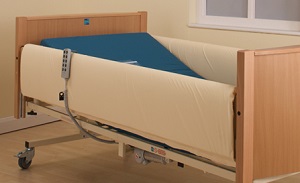 Bed bumpers are made of covered foam and fit over bed rails. Some fit all the way round the inside of the bed and are known as ‘cocoon beds’. These provide the person with dementia who experiences sleep disturbances and flailing limbs with protection from injury from hard bed rails, the bed head or foot boards..
Bed bumpers are made of covered foam and fit over bed rails. Some fit all the way round the inside of the bed and are known as ‘cocoon beds’. These provide the person with dementia who experiences sleep disturbances and flailing limbs with protection from injury from hard bed rails, the bed head or foot boards..
Wardrobes and chests of drawers
Wardrobes and chests of drawers that have an open viewing section or clear viewing panels, so it is easy to see what is inside, can allow a person with dementia to maintain independence and reduce confusion or anxiety when accessing and selecting clothing.
If the clothes storage does not have open or clear panels, then clear signs indicating what is inside can be helpful.
Assessing your needs
A range of conditions may cause forgetfulness, anxiety, low mood and confusion, however they may also be early signs of dementia. A visit to your GP would be recommended to rule out other causes and allow for a better understanding of the illness and how it may progress, as well as strategies on how to manage the symptoms.
The assessment for dementia is a process that takes time and goes through various stages and tests. These may include a physical examination, a blood test and interviewing both the person and their concerned friend/relative separately. This may lead to a referral to a local memory service or clinic. The GP, Community Psychiatric Nurse or a member of the memory clinic staff will be able to advise on symptoms, how the disease may develop and provide information on appropriate treatment. They will also be able to advise you on what support there is available locally. Prior to an appointment it can be useful to keep a journal or diary of any tasks that have become more difficult or concerns that you may have.
The GP can refer you for a Health and Social Care Needs Assessment, or you can contact your local authority Adult Social Care Department and make a self-referral, or have a friend or relative do it for you. By law anyone who appears to need care and support can request an assessment regardless of their income or savings.
The assessment will focus on your needs, how they impact on your well-being and on what you want to achieve and will aim to identify any difficulties you may have in caring for yourself. An Occupational Therapist will carry out the assessment and will be able to advise on strategies to help reduce any identified risks and recommend any equipment that may be helpful to maintain independence. If someone else is helping you they are also entitled to a carers assessment, which will help to identify what help and support they may need.
There are a number of charitable organisations listed below that can provide help and support for the person with dementia and their relatives and carers.
Provision of equipment
Many simple assistive technology devices mentioned in this fact sheet can be privately purchased. Others can be provided by local authorities or the NHS to meet an assessed need; you or a family member can request a home assessment from an occupational therapist
Permanent loan: Local Authority and health provision
If you require disability equipment, telecare or adaptations to your home then your local authority may be able to help. They can supply equipment or minor adaptations that cost under £1,000, free of charge. (Department of Health 2014, section 2.9). In Scotland, Local Authorities make their own arrangements for provision of minor adaptations and details can be accessed via your Council's website.
Some equipment such as pressure relieving cushions, mattresses, some mobility aids and wheelchairs are supplied by your local Health Authority. A referral to the District Nurse or Wheelchair Service for these items can be made via your GP or other health professionals including a Community Occupational Therapist or Physiotherapist.
Disabled Facilities Grant (DFG)
Should you need adaptations to your home that cost more than £1,000 that will allow you to continue to live there, you may be eligible for a Disabled Facilities Grant (DFG). An Occupational Therapist will complete an assessment and if the work is deemed necessary to meet your needs and is reasonable and practical, then they will arrange for a financial assessment to be undertaken.
If you meet the criteria for funding, the Occupational Therapist will make recommendations for the adaptations required.
Private purchase
If you do not wish to use local authority services, there are independent Occupational Therapists who can assess your needs and help to advise or assist you in buying any equipment or arrange adaptations to your home that you may require.
You can also purchase equipment privately, but it is recommended that you compare different options first. There may be an equipment demonstration centre near you where you can look at and try out equipment before purchasing, as well as receiving impartial advice.
Charity and Grant funding
Charitable trusts may sometimes provide equipment or give a grant for equipment purchase.
Turn2Us is a national charity that helps people who are in financial difficulty find grants for the provision of equipment, and Community Care gives a list of charitable organisations that give grants.
Charities tend to give awards in accordance with a predetermined criterion, so it is important that you carefully select the organisations that apply to your condition. There are also some workplace charities that will provide support for ex-employees. If you are or have served in the Armed Forces, or are a dependent or carer of a person who has served, The Royal British Legion may be able to provide you with support for specialist dementia care or grants for equipment and adaptations to your home, or small crisis grants to meet unexpected expenses.
Funding sources for care
If you need support with daily tasks that may include help from a carer, the delivery of meals or residential care then your local authority may help with the cost. How much support you are entitled to will depend on your income and savings and what your care needs are. A financial assessment of your means will be carried out to establish how much support you are entitled to.
You may be eligible for further financial support such as Attendance Allowance or Personal Independence Payment (PIP) and if you have a person who cares for you for 20 hours or more a week, they may be eligible for some financial support.
If you live alone you can apply to your local authority for a 25% reduction on your Council Tax bill, or if you live with someone else then they may be eligible for a 25% reduction on the Council Tax bill. As your condition progresses, they may be eligible for a further 25% reduction.
Private carers and residential care
If you are looking for a carer or are considering residential care, then you should ensure that the staff are trained in dementia care and are able to give the specialist help you need. A residential home should be designed to provide the best possible environment for you. There are a number of organisations that can help you with choosing a suitable home, including:
- Elderly Accommodation Council
- Housing Care.org
- DementiaUK
- Relatives and Residents Association
- Paying for Care
Care Home ratings/selector
Inspection reports and care home ratings can be found via:
- England – Care Quality Commission
- Scotland – Care Inspectorate
- Wales – Care Inspectorate Wales
- Northern Ireland – Regulation and Quality Improvement Authority
Charity and Grant funding
Charitable trusts may sometimes provide funding for care, nursing or residential respite, permanent care or a befriending service. Charities tend to give awards in accordance with a predetermined criterion, so it is important that you carefully select the organisations that apply to your condition. There are also some workplace charities that will provide support for ex-employees. If you are or have served in the Armed Forces, or are a dependent or carer of a person who has served, The Royal British Legion may be able to provide you with support for specialist dementia care or small crisis grants to meet unexpected expenses.
Further information relating to grants is available from:
- Community Care – a list of charities providing grants.
- Turn2us - Turn2us is a national charity that helps people in financial hardship gain access to welfare benefits, charitable grants and support services.
- Housing grants information from Disability Rights UK - led by people with diverse experiences of disability and health conditions, from different communities.
- Disability Grants - grants for disabled adults.
- My grants - accessibility grants for disabled and older people.
- Grants for individuals - this website is run by the Directory of Social Change and lets subscribers search for grants. It is intended for organisations searching for funding on behalf of individuals.
- The Money Advice Service - Charitable grants and major and minor adaptations.
VAT relief
If you have a diagnosed long-term condition, you may be able to claim VAT relief on purchases relating to the condition. The company supplying the equipment should be able to advise you, or there is general information on VAT relief on the GOV.UK website.
For further advice from us
For clear, practical advice and information on products and suppliers of daily living equipment, please have a look at our Living made easy website.
If you would like further advice related to choosing equipment for everyday living you could try relevant sections of AskSARA, our free online guided advice tool. AskSARA will ask you questions about yourself and your environment and then offer relevant advice, product suggestions and supplier details.
You can contact the DLF Helpline, which is open Monday to Friday from 10am to 4pm. Tel: 0300 999 0004 (calls charged at your standard land line rate even if you are phoning from a mobile).
Alternatively, you may wish to contact us via email: info@dlf.org.uk or by letter: DLF, 34 Chatfield Road, Wandsworth, London SW11 3SE.
To help us give you a concise and informative reply, please provide us with as much detail as possible, including information on the difficulties you are having and any solutions you have considered, such as equipment ideas.
Another source of advice is a disabled or independent living centre where you would have the opportunity to try out a range of equipment. There are several of these around the country where you can go for impartial advice. Your local authority will also be able to give you details of centres in your area.
Contributors
Gill Creighton
 Gill Creighton qualified as an Occupational Therapist is 2009 and worked for Local Authority Social Services as a community OT and Assistant Team Manager, and in Community Equipment Services as a Specialist Clinical Advisor. She has experience in working with children and adults with a wide range of disabilities and health conditions. Gill is now working as an independent OT providing a range of services including assessment and treatment, moving and handling training and expert witness.
Gill Creighton qualified as an Occupational Therapist is 2009 and worked for Local Authority Social Services as a community OT and Assistant Team Manager, and in Community Equipment Services as a Specialist Clinical Advisor. She has experience in working with children and adults with a wide range of disabilities and health conditions. Gill is now working as an independent OT providing a range of services including assessment and treatment, moving and handling training and expert witness.
Roisin Hodgson
 Roisin Hodgson qualified as an occupational therapist in 1993 and has worked extensively in hospitals and within the community. Now working as a private occupational therapist, Roisin has an interest in occupational therapy approaches to anxiety, panic and post traumatic stress disorder. Many of Roisin's clients have dementia; she works with them and their families advising on a range of solutions to help maintain independence, including home adaptations, daily living aids and telecare.
Roisin Hodgson qualified as an occupational therapist in 1993 and has worked extensively in hospitals and within the community. Now working as a private occupational therapist, Roisin has an interest in occupational therapy approaches to anxiety, panic and post traumatic stress disorder. Many of Roisin's clients have dementia; she works with them and their families advising on a range of solutions to help maintain independence, including home adaptations, daily living aids and telecare.
Nina Evans
 Nina Evans works alongside the design team at Designability. Working in partnership with users, carers and professionals, Nina carries out clinical trials with end-users, developing and promoting assistive technology to improve quality of life. Nina's qualifications include a Diploma of the College of Occupational Therapists and an MSc in Clinical Research.
Nina Evans works alongside the design team at Designability. Working in partnership with users, carers and professionals, Nina carries out clinical trials with end-users, developing and promoting assistive technology to improve quality of life. Nina's qualifications include a Diploma of the College of Occupational Therapists and an MSc in Clinical Research.
Useful organisations and resources
Age UK Advice is a free, confidential, national phone service for older people, their families, friends, carers and professionals. Their team of experts can provide advice and information on a number of topics including benefits, concerns about hospital stays, advice choosing care homes etc. The website can signpost you to local services including home helps, foot care, handy person services and dementia support.
The Age UK network includes Age Scotland, Age Cymru and Age NI.
Alzheimer's Society's website provides advice and support regarding all aspects of dementia – including the different types of dementia, symptoms, diagnosis and treatments available. They also run Dementia Connect, a comprehensive services directory for people affected by dementia - areas cover England, Wales and Northern Ireland.
.
Website: www.alzscot.org
24 hour Dementia Helpline: 0808 808 3000
Alzheimer Scotland provides a wide range of specialist services for people with dementia and their carers. They offer personalised support services, community activities, information and advice at every stage of the dementia journey.
Disabled Living
Burrows House, 10 Priestley Road
Wardley Industrial Estate, Worsley
Manchester, M28 2LY
Website: www.bbuk.org.uk
Telephone: 0161 607 8219
Email: bbuk@disabledliving.co.uk
Bowel and Bladder UK's National Confidential Helpline is managed by a team of Specialist Nurses and Continence Product information staff, who can be contacted for advice on specialist services, product information and general advice to help treat or manage bladder and bowel problems that may occur as a symptom of Dementia. Opening hours Monday to Friday 9am–4.30pm.
5th Floor, Charles House
148/9 Great Charles Street Queensway
Birmingham, B3 3HT
Website: www.bda.uk.com
Telephone: 0121 200 8080
The BDA is the only body in the UK representing the whole of the dietetic workforce. It is a trade union and professional body representing the professional, educational, public and workplace interests of its members.
Head Office
20 Great Dover Street
London SE1 4LX
Website: www.carersuk.org
Telephone: 020 7378 4999
Carers UK provide advice and support for all carers, whether they are new to looking after someone or have been a carer for a long time. Their telephone advice and support service is available if you wish to talk to someone about caring, with further information and advice available on the website. The website also provides contact details for Carers Wales, Scotland and Northern Ireland.
Carewatch Care Services Ltd
Libra House, Sunrise Parkway
Linford Wood
Milton Keynes MK14 6PH
Website: www.carewatch.co.uk
Telephone: 01908 557 950
Carewatch provide home care services throughout the UK, designed to enable people to remain as independent as possible within their own home. They offer multiple services including home visits, personal care, practical help, live-in care and dementia care at home and long term home care.
Dementia Friends provides information, support and learning for those who have a relative or know someone with dementia. Anyone of any age can be a dementia friend. Visit their website for more details.
Second Floor
356 Holloway Road
London N7 6PA
Website: www.dementiauk.org
Telephone: 020 7697 4160
Support line: 0800 888 6678
Dementia UK provide specialist dementia support for families through their Admiral Nurse service. The Admiral Nurses work with families giving one-to-one support, expert guidance and practical solutions.
Unity House
Westwood Park
Wigan, WN3 4HE
Website: www.lewybody.org
Telephone: 01942 914000
Support line: 0800 888 6678
Email: info@lewybody.org
The Lewy Body Society funds research into Dementia with Lewy Bodies (DLB). It's mission is to raise awareness of DLB among the general public and those in the medical profession and decision making positions, They also provide information resources for patients and carers.
Website: www.nhs.uk
NHS Choices provides comprehensive information on the help and support available for people living with dementia. Other NHS websites include: NHS Inform (Scotland), Health and Social Care online (N.I.) and NHS Direct Wales.
Website: www.nhs.uk
The Patient Advice and Liaison Service from the NHS offers confidential advice, support and information on health-related matters. They provide a point of contact for patients, their families and their carers when using NHS services. Your local PALS service can be located using the search facility on their website.
Website: www.nice.org.uk
NICE provides national guidance and advice to improve health and social care.
The RICE Centre
Royal United Hospital
Combe Park
Bath, BA1 3NG
Website: www.rice.org.uk
Telephone: 01225 476420
Email: info@rice.org.uk
RICE is a registered charity committed to undertaking and publishing effective research aimed at improving the diagnosis, assessment and treatment of people with Alzheimer’s disease and other forms of dementia. The charity also offers several healthcare services for people living with dementia including a memory clinic.
106-114 Borough High Street
Southwark
London SE1 1LB
Website: www.rcot.co.uk
Telephone: 020 7357 6480
Email: reception@rcot.co.uk
The Royal College of Occupational Therapists is the professional membership body for occupational therapy staff in the UK. Their website includes information on how to find an independent occupational therapist through their online directory.
2 White Hart Yard
London SE1 1NX
Website: www.rcslt.org
Telephone: 020 7378 1200
The RCSLT is the professional body for speech and language therapists in the UK providing leadership and setting professional standards.
81 Oxford Street
Glasgow, G5 9EP
Website: www.sdwg.org.uk
Telephone: 0141 410 1171
Email: sdwg@alzscot.org
Funded by Alzheimer Scotland and the Scottish Government SDWG is an independent group run by people with dementia, their families and carers, which campaigns on behalf of, and provides a voice for, people living with dementia in Scotland.
Watson House
54 Baker Street
London W1U 7EX
Website: www.scie.org.uk
Telephone: 020 7766 7400
Email: info@scie.org.uk
The Social Care Institute for Excellence (SCIE) improves the lives of people who use care services by sharing knowledge about what works. It is a leading improvement support agency and an independent charity working with adults’, families’ and children's care and support services across the UK. The website contains a library of resources and services on wide range of topics, including dementia.
SFE Administrator
Studio 209, Mill Studio Business Centre
Crane Mead
Ware
Hertfordshire, SG12 9PY
Website: www.sfe.legal
Telephone: 0844 567 6173
Email: sfe@standagency.com
Solicitors for the Elderly provide a service to help you locate a local solicitor, near you, to help you with wills, power of attorney, trusts, probate, paying for care and other legal needs. They are a national organisation across the UK and the Republic of Ireland
Wimslow House
Water Lane
Grove Way
Wimslow, SK9 5AG
Website: www.tsa-voice.org.uk
Telephone: 01625 520320
Email: admin@TSA-Voice.org.uk
The website has information on the telecare industry and the services it provides to individuals. The TSA aims to promote and support the telecare industry and highlight the benefits of telecare for service users, their friends, family and carers.
Released January 2019, to be reviewed by January 2022, Version 1
References and further reading Show references
Marshall M (2005) Persepectives on Rehabilitation and Dementia. Available at:
https://www.alzheimers.org.uk/about-dementia/symptoms-and-diagnosis/how-dementia-progresses
Harvard Med School. Helpguide.org (2018) Alzheimer’s Disease
Recognizing the Symptoms and Coping with a Diagnosis. Available at:
https://www.helpguide.org/articles/alzheimers-dementia-aging/alzheimers-disease.htm
The Dementia Services Development Centre, Colour and Contrast. Available at:
http://dementia.stir.ac.uk/design/good-practice-guidelines/colour-and-contrast
Dementia Enabling Environments. Colour Perception and Contrast. Available at:
https://www.enablingenvironments.com.au/colour-perception-and-contrast.html
UKS Mobility.com . The Importance of Colour and Contrast in Dementia. Available at:
https://www.uksmobility.co.uk/blog/2015/05/the-importance-of-colour-and-contrast-in-dementia/
Alzheimer’s Society. Making Your Home Dementia Friendly. Available at: https://www.alzheimers.org.uk/sites/default/files/migrate/downloads/making_your_home_dementia_friendly.pdf
SCIE. Dementia Friendly Environments, Bedrooms. Available at: https://www.scie.org.uk/dementia/supporting-people-with-dementia/dementia-friendly-environments/bedrooms.asp
NHS Choices. Home Environment and Dementia. Available from: https://www.nhs.uk/conditions/dementia/home-environment/
NHS Improvements. Patient-led assessments of the care environment. Dementia-friendly environments: guidance for assessors. Available from: https://digital.nhs.uk/data-and-information/areas-of-interest/estates-and-facilities/patient-led-assessments-of-the-care-environment-place
Which? Riser recliner chair features explained. Available at: https://www.which.co.uk/reviews/riser-recliner-chairs/article/riser-recliner-chair-features-explained
Cornawall.gov. Clinic Criteria for the Provision of Seating. Available at: http://www.cornwall.gov.uk/media/9946990/Clinical-Criteria-8-SEATING.pdf
Peverel Court Care. Fiddle Cushions Create Positive Experience for Merryfielkd Residents with Dementia. Available at: http://peverelcourtcare.co.uk/fiddle-cushions-create-positive-experience-for-merryfield-residents-with-dementia/
Alzheimer’s Society. Pressure Ulcers Factsheet 512LP. Available at: https://www.alzheimers.org.uk/sites/default/files/migrate/downloads/factsheet_pressure_ulcers_bedsores.pdf
Seating Matters. Common Mistakes made when using pressure cushions. Available at: http://blog.seatingmatters.com/mistakes-made-pressure-cushions
RIDC. Remote Controls. Available from: https://www.ridc.org.uk/content/tv-remote-controls
Age UK. At Home with Dementia. Available at: https://www.ageuk.org.uk/globalassets/age-uk/documents/information-guides/ageukig55_at_home_with_dementia.inf.pdf
Wakefield Integrated Community Services. Practice Guidelines for the Provision of Equipment. Available from: http://www.southwestyorkshire.nhs.uk/documents/959.pdf
Health & Safety Executive. Safe Use of Bed Rails. Available at:
http://www.hse.gov.uk/healthservices/bed-rails.htm
NAEP. Bed Rail Provision. Guidance for Assessment and Provision. Available at:
http://naep.org.uk/members/documents/BedRailProvisionGuidanceDocIssue1.pdf
Caregiver Orange County. Dementia bedding, Cocoon bed for Dementia Sufferers. Available at:
http://www.caregiverorangecounty.com/Dementia-Bedding-Cocoon-Bed%20for-Dementia-Sufferers-from-Health-and-Care.htm
Science Direct, Colour knowledge in semantic dementia: It is not all black and white. Available at: https://doi.org/10.1016/j.neuropsychologia.2007.06.020
Woodbridge, R, Sullivan, MP, Harding, E. (2016) Use of the physical environment to support everyday activities for people with dementia: A systematic review
Vasudevan Lakshminarayanan, V, Lagrave, J, Kean, ML, Dick, M, Shankle, R (2016) Vision in dementia: Contrast effects p 9-15.
AskSARA
If you would like further advice regarding daily living equipment related to choosing equipment for everyday living you could try relevant sections of AskSARA. AskSARA is our free online guided advice tool. AskSARA will ask you questions about yourself and your environment and then offer relevant advice, product suggestions and supplier details.
Visit AskSARA's Your home section
| Attachment | Size |
|---|---|
| 26.01 KB | |
| 19.52 KB | |
| 43.95 KB | |
| 12.13 KB | |
| 19.16 KB | |
| 20.42 KB | |
| 30.44 KB | |
| 17.36 KB | |
| 20.38 KB | |
| 24.01 KB | |
| 33.36 KB | |
| 13.88 KB | |
| 22.6 KB | |
| 18.22 KB | |
| 46.97 KB | |
| 15.9 KB | |
| 30.38 KB | |
| 27.31 KB | |
| 14.02 KB | |
| 23.31 KB | |
| 31.83 KB | |
| 51.27 KB | |
| 8.75 KB | |
| 46.65 KB | |
| 42.61 KB | |
| 775.41 KB |
All rights reserved. No reproduction or transmission of this publication may be made without written permission. Inclusion (including any sponsorship) does not indicate endorsement or that any item has been recommended or tested. All information is provided without legal responsibility.
Disabled Living Foundation, Tel: 020 7289 6111, Fax: 020 7266 2922, Helpline: 0300 999 0004 10.00am-4.00pm, Email: helpline@dlf.org.uk, Website: www.dlf.org.uk
Reg. Charity No: 290069, VAT Reg. No: 226 9253 54
 (Tell me about the standard)
(Tell me about the standard)

Your personal information is required in order to claim Gift Aid. This information is kept by DLF/Shaw Trust for financial audit purposes. For more information on our privacy policy visit: https://www.dlf.org.uk/content/privacy-policy








